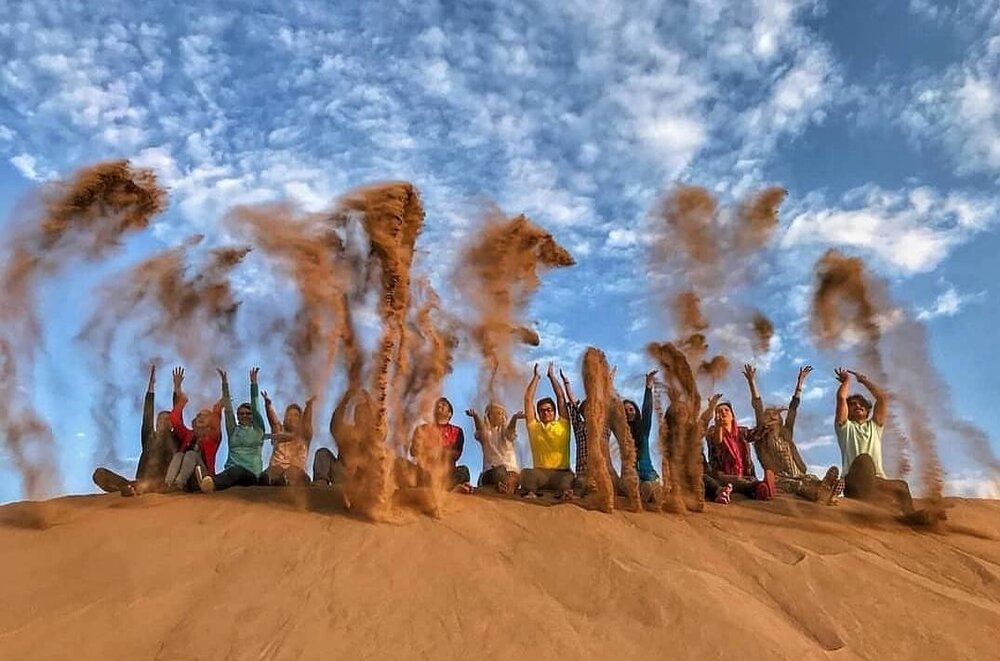Tourism key to economic prosperity in desert areas, expert says

TEHRAN – Tourism is essential to the economic development of desert areas, a nature tourism expert has said.
“Paying attention to desert-based tourism is the way to ensure economic prosperity in desert regions of Iran,” ISNA quoted Farid Javaherzadeh as saying on Saturday.
In present-day Iran, about three-quarters of the country is desert, so utilizing these areas is a tremendous opportunity for economic growth and the livelihood of the people, which should be taken advantage of, and there should be serious consideration of tourism in the desert, he explained.
While tourism has the potential to preserve ecosystems, water resources, and even natural areas, in previous years, there was a neglect of the desert, while many areas of the country have little water or no water at all, and suffer greatly from limited resources, he added.
Many European citizens are very interested in desert tourism, as it is a natural ecosystem that many countries are lacking, so desert tourism can be an attractive field of tourism, he noted.
“Dunes, various species of animals, plant life, and the horizon found in a desert as well as changing climatic conditions have made the desert a tourist attraction worldwide.”
Even in famous historical travelogues, there are sections about desert and desert tourism in the countries of the region, especially countries on the Silk Road, he stated.
Although there are many hardships of desert tourism, many tourists cross these deserts, making adventure trips for themselves as the geographical and climatic features of the desert have made it a sustainable ecosystem and a tourist center, he mentioned.
“However, to prevent tourists from damaging the environment, studies should be performed and indicators and criteria established so as not to damage ecotourism sites.”
Activities in this tourism branch can be hiking, camel riding, nature therapy, sun therapy, sand therapy, nature meditation, cycling, motorcycling, rally, sand skiing, hang gliding, and observing the desert sky at night, he concluded.
Central Iran is home to vast deserts known worldwide, of which UNESCO-registered Lut, Rig-e Jenn, and Maranjab deserts are more famous.
The Lut Desert, widely referred to as Dasht-e Lut (“Emptiness Plain”), is a large salt desert encircled by the provinces of Kerman and Sistan-Baluchestan, and South Khorasan. It is the world’s 27th-largest desert and was inscribed on UNESCO’s World Heritage List on July 17, 2016.
The vast desert is teemed with giant dunes, shifting sands, salt plains, and wind-hewn kaluts, offering visitors epic journeys of breathtaking beauty and wilderness. It is a destination for people who are in search of new adventures; outstanding scenery and unparalleled serenity.
It is considered one of the top areas in the world for finding meteorites, thanks to its unique parameters. In recent years, significant finds have been made, with the efforts of national and international teams of researchers. Seven years of satellite temperature data analyzed by NASA show that the Lut Desert is the hottest spot on Earth. Based on the research, it was the hottest during 5 of the 7 years and had the highest temperature overall: 70.7°C in 2005.
Rig-e Jenn (“Dune of the Jinn”) is a barren and desolate place dominated by enormous sand dunes that defy avid skillful sightseers, adventurers, and motorists driving 4WD vehicles.
Rig-e Jenn is in fact home to giant sand dunes, and vast swamps that could pose a serious challenge even to passionate trekkers with arduous hikes and scarcity of water.
It is situated in a border area between Semnan and Isfahan provinces. In another world, it is part of Dasht-e Kavir (the central desert of Iran). The bizarre desert can be reached after hours first on asphalt roads, and then for some hours through uninhabited terrain.
Rig-e Jenn assumed its name from whom believed that it was haunted by spirits and the devil. This say-so was strengthened by, or probably originated from the fact that perhaps many had entered the desert and never returned.
Narratives say that even caravans used to skip passing through Rig-e Jenn, believing it to be a place where evil spirits and “jinn” dwell. A “jinn” is a spirit in Islamic culture and Rig-e Jenn was once (and in some places still) believed to accommodate evil spirits.
Popular for off-roading, Maranjab is one of the most popular deserts in Iran situated about 60 Km from Kashan in a northeast direction.
The desert is surrounded by a salt lake from the north, Band-e Rig Desert and National Park from the east, Masileh Desert, Hoz-e sultan and Moreh Lakes from the west and eventually Aran-Bidgol from the south.
Shah Abbasi Caravanserai of Maranjab is one of the landmarks of this stunning desert. This structure was built in 1012 AH by the order of Shah Abbas, the Safavid monarch, along the Silk Road so that the passengers, most of whom traveled through deserts, would spend nights in this roadside inn.
A well is located five kilometers east of the caravanserai and stores fresh and drinkable water. The reason for the purity of the water is the layers of sand that absorb the salt and purifies the water.
Although it has a harsh environment, visitors may find plenty of salt-friendly plants on the margins of the tranquil desert. Besides, it is home to some the desert birds and reptiles like eagles, snakes, and lizards.
ABU/MG
Leave a Comment